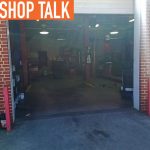For some in the work truck segment, the shop is referred to as the warehouse or the garage. It’s the place where grease and grime collect and dust bunnies hibernate. If the walls could talk, catch phrases, such as “just fix it” and “heading home,” would echo off the concrete floor. From oil leaks to low tires, work crews handle the task of keeping the fleet in prime operating mode. At the end of a long day or week, the conversations tilt towards off-time and relaxing. The day starts and ends in the shop; it’s at the core of company operations.
When my dad built his shop, the neighbors thought it was a survival bunker in case of some catastrophic event. Adding drama to the project, the excavator operator hit a massive rock while digging the basement. Dad told the guy to just leave it and clear around it. The digging also unearthed free-flowing water that was tapped for a natural water supply. Once the basement floor was poured and cinder block in place, the forms were readied for the 12-inch cement floor, complete with a closing hatch to seal the basement from the elements. The building was finished with scrap lumber, refurbished windows, and an old garage door. Not exactly a bomb shelter, but definitely a shop with character.
TOOLS AND SAWDUST
More than one workbench anchored the walls on the first floor and in the basement. Various tools and odd-shaped wood scraps adorned the space. A wood-burning stove made from a steel barrel heated the shop in the winter. It was a sanctuary for thinking while fixing a carburetor or tuning an old engine. Even the cat found a spot on an old, swivel desk chair not far from the only heat source. Sawdust was scattered from the entrance to the back of the shop, and no one minded. Work commenced in and around whatever vehicle occupied the “fix it” space. Conversations were light as the NPR radio station blared from a high spot near the back door.

If spare parts were needed, a trek out the back door led to a path through the garden. At the edge of the black dirt, just beyond the grove, old pickups and a salvaged chassis could be found nestled in the tall grass. A junk pile of metal odds and ends sat at the corner of the property, out of view from the highway. Occasionally, there would be a short trip to town for a stop on Main Street at the general store for a gasket or quart of oil. As the sun would dip lower in the late afternoon, workers would pause for supper and leave whatever tool next to their work area. The day was done.
THE MODERN GARAGE
Dad’s shop existed in a simple time, uncomplicated with the latest technology and dedicated to its task. The warehouse or garage of today that handles a fleet of work trucks is more fast-paced and sensitive to spare parts inventory. Today’s shop is a buzz with chatter of the day’s workload and tomorrow’s scheduled maintenance. Work crews hop in and out of company work trucks as tasks are completed in various industries, such as HVAC, plumbing, landscaping, utility, municipalities, and more.
SHOP TALK
Introducing a new column in this editorial space, Modern WorkTruck Solutions will take you behind the shop door and introduce you to some of the men and women who occupy the driver’s seat of today’s work trucks and those who manage the operations across fleet-driven industries. Tune in next month as we switch gears from talking about the issues to talking shop.
ABOUT THE AUTHOR:

Donna Campbell is editor in chief of Modern WorkTruck Solutions and Modern Contractor Solutions. This monthly column will feature commentary on trending issues for work truck and transportation matters.
_______________________________________________________________________
MODERN WORKTRUCK SOLUTIONS: OCTOBER 2016 ISSUE
Did you enjoy this article?
Subscribe to the FREE Digital Edition of Modern WorkTruck Solutions magazine.
![]()




